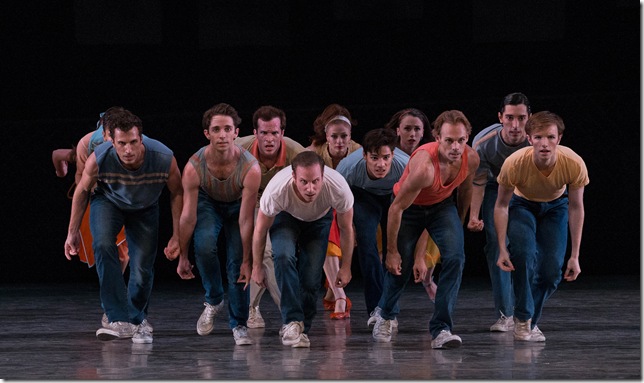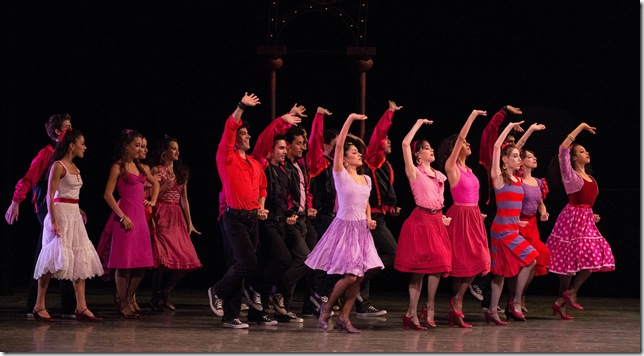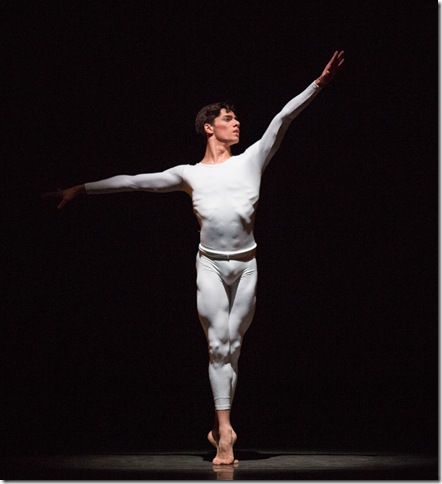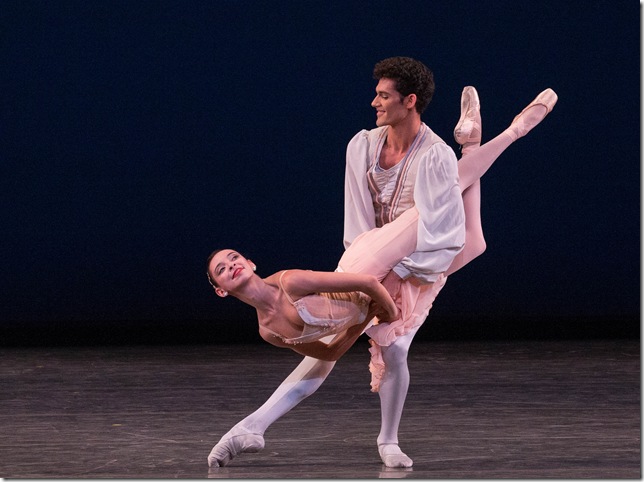By Tara Mitton Catao
Artistic Director Lourdes Lopez opened Miami City Ballet’s Program III at the Kravis Center on Friday night and introduced two company premieres that two dance legends — George Balanchine and Jerome Robbins — created decades ago.
Lopez, who danced as a soloist and principal with New York City Ballet under the tutelage of these trend-changing choreographers, referred to them affectionately as Mr. Balanchine and Jerry. One sensed that it never could have been George and Jerry.
The two works were quintessentially representative of these iconic choreographers. One reflected the formality of Mr. Balanchine’s choreography as he explored a new ballet vocabulary. The other reflected the theatrical base of Jerry’s choreography as he explored the dynamics of the streets with the creation of his hip urban moves that gave the musical West Side Story so much success on Broadway.
Lopez personalized the company’s artistic journey and the challenge that the dancers faced as they took on the Triple Threat program. No doubt it was a big jump — or should I say jeté? The company had to go from Episodes, a courtly and minimal ballet done in practice clothes and pointe shoes, to West Side Story Suite, with its acting, singing and athletic dancing done in sneakers and heels.
There was also a video clip of the rehearsal process showing the dancers learning to sing while dancing. Not an easy feat for a ballet dancer. As a result of these introductions, it was natural for the audience to become invested in the artistic growth that the MCB dancers experienced while preparing for Program III.
West Side Story Suite was composed of seven dances, some of which were from Robbins’ famous musical, and some of which were created for this suite when he decided, almost 40 years later, to make a version for the ballet. Though it looked somewhat dated, the historic choreography of the tragic love story of Maria and Tony amid urban cultural tensions (which still very much exist today) made for good entertainment, and with the wonderful music of Leonard Bernstein and the familiar lyrics of Stephen Sondheim, it was enjoyable.
Was the test of the “triple threat” met? Where the dancers equally adept at dancing, acting and singing? No, not really. The singing was uneven, and there was an element of confusion as to who was singing, as some songs were sung offstage, some onstage and others amplified with microphones. The acting was stronger, and the dancing was naturally the strongest and best performed.
Who really excelled was Jeanette Delgado as Anita in “America.” Sassy and confident, she took to the singing and dancing of the famous tune with an undeniable ease and a vibrant energy that made her look like she had had a secret life on Broadway before joining MCB.
Episodes, which opened the program, was created in 1959 during a time when Balanchine was still adjusting and absorbing America’s new ways after leaving Russia with its strict adherence to traditional ballet. The choreography was quite precise and almost stark in its formation and courtly formality. Using music by Anton Webern that was almost sparse, Balanchine juxtaposed traditional ballet vocabulary with what has now become recognized as traditional Balanchine moves — thrusted hips, flexed feet and angular partnering — and filled the spaces between the notes with movement. The whole work had a feeling of punctuation and clear design.
Four couples competently led four of the sections. The corps de ballet work wasn’t particularly inspired or clean. Delgado, leading the third section with partner Renato Penteado, gave a deeper dimension to the movement as she moved from one defined shape to another with the necessary clarity and with a little magic in her transitions.
The original work was a collaboration with modern dance icon Martha Graham. The Graham section is no longer performed but perhaps that original interaction might explain the extreme difference in the style of the male solo that was reinserted back into the dance for the MCB premiere of Episodes.
The solo, originally created for and danced by then-Graham dancer Paul Taylor, gave a curious balance to the work, as it was mesmerizingly fluid and dynamic. Jovani Furlan, dancing barefooted in a downward light, was absolutely stunning. His technical ease as he articulated the weighted movement and rounded torso against his cleanly executed jumps and pirouettes was a wonderful thing to behold. Furlan is a dancer to watch.
Rounding out the program was a beautiful rendition of Balanchine’s Tschaikovsky Pas de Deux danced with vibrancy by the always engaging Nathalia Arja and charismatic Renan Cerdeiro.
Miami City Ballet presents this program again at 2 p.m. Sunday at the Kravis Center. Call 832-7469 or visit www.kravis.org.



